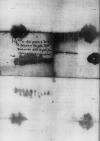Quid novi iam parit Italy (Italia)⌊ItaliaItaly (Italia)⌋ aut parturit , paucis aperiam. Fuerat per praeteritam hiemem magna formido per eandem Italy (Italia)⌊ItaliamItaly (Italia)⌋, ne Suleiman the Magnificent (*1494 – †1566), 1520-1566 Sultan of the Ottoman Empire⌊TurcaSuleiman the Magnificent (*1494 – †1566), 1520-1566 Sultan of the Ottoman Empire⌋ insuperabili potentia succinctus eam penitus desolaret. Proinde non parvae pecuniae exactae et congregatae sunt pro milite, qui Suleiman the Magnificent (*1494 – †1566), 1520-1566 Sultan of the Ottoman Empire⌊hostemSuleiman the Magnificent (*1494 – †1566), 1520-1566 Sultan of the Ottoman Empire⌋ tam potentem a finibus Italy (Italia)⌊ItaliaeItaly (Italia)⌋ coerceret. Nunc autem deprehendimus verum esse, quod pueri canunt: „Saepe facit nimios causa pusilla metus”. Nam tota classis Turcica (si praesens fama vera est) vix stain⌈[) vix]) vix stain⌉ numerum centum triremium explevit, quae tamen nunc revocata dicitu stain⌈[dicitu]dicitu stain⌉r ob insultum Tahmāsp I Safavid (Sophi) (*1514 – †1576), 1524-1576 Shah of Persia, 2nd. Shah of the Safavid dynasty, ruled 1524 - 1576. Son and successor of Ismail I Safavid ⌊regis PersarumTahmāsp I Safavid (Sophi) (*1514 – †1576), 1524-1576 Shah of Persia, 2nd. Shah of the Safavid dynasty, ruled 1524 - 1576. Son and successor of Ismail I Safavid ⌋, a quo Suleiman the Magnificent (*1494 – †1566), 1520-1566 Sultan of the Ottoman Empire⌊TurcusSuleiman the Magnificent (*1494 – †1566), 1520-1566 Sultan of the Ottoman Empire⌋ digna factis recipere solet dormientibus principibus Christianis, qui Christi adversarium ab ovili Christiano reprimere deberent etc. Sed duo maxima remedia iam praeparari videntur contra domesticos et extraneos Christi inimicos, primum in conventu Nyssensi in Savoy (Sabaudia), duchy in the northern part of the Italian Peninsula, state of the Holy Roman Empire, today partially in Italy, partially in France⌊ducatu SabaudiaeSavoy (Sabaudia), duchy in the northern part of the Italian Peninsula, state of the Holy Roman Empire, today partially in Italy, partially in France⌋, ubi nunc Paul III (Alessandro Farnese) (*1468 – †1549), 1493 elevated to cardinal; 1524 Cardinal-Bishop of Ostia; 1534-1549 Pope⌊papaPaul III (Alessandro Farnese) (*1468 – †1549), 1493 elevated to cardinal; 1524 Cardinal-Bishop of Ostia; 1534-1549 Pope⌋ constitutus Charles V of Habsburg (*1500 – †1558), ruler of the Burgundian territories (1506-1555), King of Spain as Charles I (1516-1556), King of Naples and Sicily, King of the Romans (1519-1530), Holy Roman Emperor of the German Nation (elected 1519, crowned 1530, abdicated 1556); son of Philip I the Handsome and Joanna the Mad of Castile⌊caesaremCharles V of Habsburg (*1500 – †1558), ruler of the Burgundian territories (1506-1555), King of Spain as Charles I (1516-1556), King of Naples and Sicily, King of the Romans (1519-1530), Holy Roman Emperor of the German Nation (elected 1519, crowned 1530, abdicated 1556); son of Philip I the Handsome and Joanna the Mad of Castile⌋ et Francis I of Valois (*1494 – †1547), 1515-1547 King of France; son of Charles, Count of Angoulême, and Louise of Savoy⌊GallumFrancis I of Valois (*1494 – †1547), 1515-1547 King of France; son of Charles, Count of Angoulême, and Louise of Savoy⌋ ibidem etiam praesentes ad concordiam reducere conatur stain⌈[reducere conatur]reducere conatur stain⌉ etc., alterum in concilio generali, quod nunc felici auspicio hic Vicenza (Vincentia), city in northeastern Italy, Veneto, 60 km E of Venice⌊VincentiaeVicenza (Vincentia), city in northeastern Italy, Veneto, 60 km E of Venice⌋ inchoatum est. Nam XII die transacti mensis Mai tres reverendissimi domini legati cardinales, videlicet Tommaso Campeggi (*1481-1483 – †1564), doctor of both canon and civil law; legal advisor to the pope Paul III; brother-in-law of the cardinal Lorenzo Campeggi; 1519-1550 referendary of the Segnatura Apostolica; 1520-1559 bishop of Feltre; 1523-1526 papal nuncio in Venezia; in 1530 accompanied the papal legate, cardinal Lorenzo Campeggi, at the diet of Augsburg; 1540-1550 regent of the Apostolic Chancellery; participant of the Council of Trent (DBI 17, p. 472-474)⌊CampegiusTommaso Campeggi (*1481-1483 – †1564), doctor of both canon and civil law; legal advisor to the pope Paul III; brother-in-law of the cardinal Lorenzo Campeggi; 1519-1550 referendary of the Segnatura Apostolica; 1520-1559 bishop of Feltre; 1523-1526 papal nuncio in Venezia; in 1530 accompanied the papal legate, cardinal Lorenzo Campeggi, at the diet of Augsburg; 1540-1550 regent of the Apostolic Chancellery; participant of the Council of Trent (DBI 17, p. 472-474)⌋, Giacomo Simonetta (*1475 – †1539)⌊SimonetaGiacomo Simonetta (*1475 – †1539)⌋, Girolamo Aleandro (*1480 – †1542), born in Motta di Livenza; 1528-1541 Archbishop of Brindisi, 1538-1542 Cardinal-Priest of S. Crisogono ⌊BrundusinusGirolamo Aleandro (*1480 – †1542), born in Motta di Livenza; 1528-1541 Archbishop of Brindisi, 1538-1542 Cardinal-Priest of S. Crisogono ⌋, solemniter a clero et populo in hanc civitatem introducti, principium gloriosum dederunt tam sancto et necessario concilio generali, ad cuius felicem consumationem et continuationem merito convenire deberent omnes pontifices, quibus Christiana fides sanguine et vita carior est etc.
Haec de concilii principio, quod cum continuatum fuerit, continuabo et ego scripta mea, ne Reverendissima Dominatio Vestra ignara sit earum rerum, quae hic aguntur, nec intendo me hinc transferre ante finem mensis Septembris. Et si interea voluerit Reverendissima Dominatio Vestra per me hic aliquid fieri, conabor me diligentem exsecutorem in omnibus exhibere.
Felicissime valeat Reverendissima Dominatio Vestra et me (ut semper facit) suo fraterno amore prosequatur.


 AAWO, AB, D. 6, f. 30v
AAWO, AB, D. 6, f. 30v